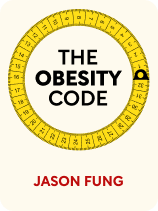

This article is an excerpt from the Shortform book guide to "The Obesity Code" by Jason Fung. Shortform has the world's best summaries and analyses of books you should be reading.
Like this article? Sign up for a free trial here .
What is Jason Fung’s The Obesity Code about? What is the key message to take away from the book?
In his book The Obesity Code, Jason Fung argues that for decades, we’ve misunderstood obesity and, as a result, have consistently failed in our efforts to curb its spread. Fung presents a new theory, arguing that obesity is a hormonal problem that causes overeating and weight gain, rather than a problem of willpower or self-control.
Below is a brief overview of The Obesity Code: Unlocking the Secrets of Weight Loss by Jason Fung.
The Obesity Code: Unlocking the Secrets of Weight Loss
Fung is a Canadian nephrologist (kidney specialist) and head of the Intensive Dietary Management Program in Toronto. After witnessing diabetes patients gain weight from insulin treatment, he began to explore type 2 diabetes and obesity, two conditions that often lead to kidney disease. The Obesity Code, published in 2016, received positive reviews and has been called one of the most comprehensive treatments of obesity yet written. Today, Fung is recognized as an expert on fasting and obesity. He continued his investigative medical writing in The Diabetes Code (2018) and The Cancer Code (2020).
In his book The Obesity Code, Jason Fung explains how the prevailing model of obesity falls short. He also lays out his recommendations for what and when to eat, and explains his perspective on intermittent fasting as the key to overcoming obesity.
A Brief History of Obesity
According to Fung, the physician Jean Anthelme Brillat-Savarin first identified the fattening role of carbohydrates as early as the 18th century. At the time, sweets, breads, beers, and starches such as white potatoes were typical European foods. Decades later, Englishman William Banting echoed Brillat-Savarin’s low-carb advice: After overcoming his own obesity by eliminating starches and sugars from his diet, he advised the public to do the same. This advice held consensus through the early 1900s, when calorie counting first came about.
Around the 1950s, American health professionals became concerned with rising rates of heart disease. At the time, scientists believed that dietary fat was the problem, so doctors began recommending a low-fat, high-carbohydrate diet. However, Fung says, deaths from heart disease weren’t rising dramatically due to dietary problems—rather, an increase in the efficacy of vaccines and antibiotics had decreased deaths from other killers, such as tuberculosis and pneumonia.
Nonetheless, doctors blamed dietary fat. This was because in the same decade, early studies on the effects of starvation concluded that weight gain and weight loss depend on “calories in, calories out.” In this model, scientists reasoned that whatever caloric energy wasn’t used became fat, so your weight depended on how you ate (calories in) and whether you exercised (calories out). Given this, researchers believed that dietary fat—a high-calorie food—causes weight gain.
This view on low-fat diets became orthodoxy in 1977, when the US Senate Select Committee on Nutrition and Human Needs released the “Dietary Goals for the United States.” This document made official the notion that dietary fat caused both heart disease and obesity.
Soon followed the “food pyramid” recommendations for Americans, with floury, starchy carbohydrates as the recommended foundation for a healthy diet. Fung suggests that in the buzz about the dangers of fat, people forgot the previous consensus that refined carbs cause weight gain. As a result, the low-fat era began in earnest, with food producers creating numerous low-fat options. At the same time, government-sponsored programs under the banner of “eat less, move more” attempted to quell rising obesity, with little success.
However, some experts began to argue in the 1960s through the 1980s that low-fat, high-carb diets actually cause weight gain, not weight loss. Notably, physician Robert Atkins advocated for a high-fat, low-carb diet that seemed to promote significant weight loss. Against this medical heresy, the American Heart Association (AHA) continued to push a low-fat, high-carb diet and, Fung suggests, took money from big food producers who profited from cheap, refined, carb-based foods.
The Current Model of Obesity
Today, the prevailing view holds that obesity is a problem of calories in, calories out. Established decades ago, this orthodox view suggests that weight gain results from eating too much and exercising too little. So, Fung says, experts pushed the “eat less, move more” program on the American public.
On a technical level, we define obesity according to body mass index (BMI). BMI is a ratio of your height compared to your weight—that is, it approximates how wide you are compared to how tall you are. A ratio over 30 is considered obesity.
The Prevailing Model Has Failed
Fung argues that the “calories in, calories out” theory fails to capture the full picture of obesity. Excess calories play a part, but they aren’t the root cause of obesity. More specifically, this theory fails to understand that obesity is a hormonal disease, rather than a problem of willpower or bad eating habits.
And, Fung says, failing to understand the root cause prevents us from beating this disease. He lays out five mistaken premises that hamper the current model of obesity.
Mistaken Premise #1: “All Calories Are the Same”
Traditionally, experts have reduced all foods to calories, or units of food energy, and treated calories as the most important aspect of any food. However, Fung asserts that not all calories are the same. For instance, 100 calories of high-fructose corn syrup is quite different from 100 calories of salmon. Research supports this view, showing that different foods cause different metabolic and hormonal reactions in the body. Because obesity is a hormonal disease, this means that various foods have different impacts on obesity.
Mistaken Premise #2: “Calories In and Calories Out Function Independently”
As Fung explains, these variables in fact depend on each other. Your metabolism adapts to your caloric intake: When you eat less, your metabolism slows down to conserve energy. When you eat more, it temporarily speeds up, having more energy to burn. In other words, you can’t reduce calories in without slowing calories out, and you can’t increase calories out without increasing calories in. So “eat less, move more” can’t work, because you need to eat more in order to move more, and vice versa.
Mistaken Premise #3: “Exercise Contributes to Weight Loss”
The notion that exercise leads to weight loss is a core tenet of the prevailing theory—it’s the “calories out” part. However, Fung asserts that we’ve misunderstood how the body uses energy: Exercise accounts for a percentage of total energy expenditure, but most energy goes to our “basal metabolic rate,” which includes beating our hearts and powering our brains.
Considering these other activities, exercise accounts for only around 5% of energy expenditure, so it’s too small to make a meaningful impact on weight loss. In addition, studies show that:
- The modern-day office worker expends about the same amount of calories as a modern-day hunter-gatherer tribesman who walks 15 to 20 miles a day.
- One massive study of over 50,000 overweight women found that controlling diet and exercise had no significant effect on weight loss. In contrast, some participants gained weight.
- Statistically, rates of exercise and obesity have risen in tandem—suggesting that exercise doesn’t effectively combat weight gain.
Mistaken Premise #4: “The Individual Controls Her Eating”
Fung explains that eating isn’t a conscious choice—rather, our hormones control when we feel hungry or full.
When you restrict calories to lose weight, your body senses the change and does two things to maintain your natural biological balance (homeostasis). First, it slows your metabolism to conserve energy. Second, it increases appetite by releasing ghrelin, a hunger hormone, and suppressing satiety hormones. You become tired and hungry, and your hormones all but force you to eat and regain the weight.
Because the “calories in, calories out” model assumes that people suffering from obesity are weak and slothful, it allows doctors to blame the victim instead of changing their treatments. For decades, Fung says, health professionals have shamed obese people for “failing” to lose weight. Yet it isn’t a personal failing—it’s that “eat less, move more” doesn’t work.
Mistaken Premise #5: “Unused Calories Go Directly to Fat Storage”
Here, Fung explains that it’s a mistake to assume that all unused calories go directly to fat storage. That is, the belief that fat storage works like a waterskin—the more you add without removing any, the larger it gets. However, research shows that various hormones such as leptin and adiponectin mediate fat storage. What this means, Fung argues, is that whether you store excess calories as fat depends on your hormones, not on whether you burn enough energy. Therefore, obesity must be a hormonal problem, not a calorie problem.
We Need a New Theory of Obesity
Given the failings of the dominant theory, Fung contends that we need a new, comprehensive theory of obesity. When we better understand obesity, we can create more effective treatments and turn the tides on this epidemic. Fung highlights two problems with existing theories:
- Problem #1: Most theories address only one factor. Fung argues that most theories of obesity contain a grain of truth, yet fail to capture the larger picture—that obesity is a “multifactorial” disease.
- Problem #2: Most theories use short-term studies. This is a problem because obesity develops over decades—so you need sufficiently long-term studies to understand how it starts, develops, and sets in over time. Theories based on short-term studies won’t cut it.
Obesity Is a Hormonal Problem
In this section, we’ll lay out Fung’s theory of obesity. We’ll start from the full picture and then break down one part at a time, until we’ve unfolded each aspect of the theory.
In short, Fung contends that obesity results from a hormonal dysfunction that centers on chronically high insulin levels. Chronically high insulin throws your body’s fat storage out of balance, disrupts your hunger hormones, and drives intractable weight gain. Here’s how.
Fat Storage Depends on Your Set Weight
Fat storage, Fung explains, hinges on the interaction between insulin and your “set weight.” Simply put, normal insulin levels stimulate your body to store a fixed amount of fat, depending on how small or large you are. That default amount of fat is called your set weight, and your body constantly works to maintain it.
If you fall beneath your set weight, your body will store calories as fat in order to reach it. If you go above your set weight, your body will increase your metabolism to burn off fat and reach it. This works similarly to cruise control in a car. Set at 55 mph, you can brake or accelerate but, when left alone, the car will always return to 55 mph.
Fung explains that if your insulin levels become chronically high, your set weight increases. Returning to the car analogy, chronically high insulin levels increase the cruise control setting—locking you in at a “higher speed.” Set weight sets the amount of fat you store, so if your set weight becomes abnormally high, your body thinks that you have insufficient fat stores. To correct this, three things change:
- It decreases metabolism, lowering your body’s energy expenditure so that more food energy can become fat.
- It decreases satiety—insulin suppresses leptin, a hormone that makes you feel full, so that you struggle to feel satiated.
- It increases hunger, prompting you to eat enough to reach that higher set weight.
This effectively compels you to overeat in order to store fat until you reach the weight your body “thinks” it should be at. Thus, Fung argues, obesity isn’t caused by overeating—overeating is caused by obesity. The term “obesity” refers to the hormonal problem, and the resulting fatness is the main symptom.
Several factors contribute to the chronically high insulin levels that raise your set weight and cause obesity. They fall into two categories: what you eat, or diet composition, and when you eat, or meal timing. We’ll explain how metabolism and insulin mechanisms work under healthy conditions, and then we’ll contrast that with the disruptive conditions that cause obesity.
How the Body Processes Foods
Fung explains that when you eat, your body breaks down the three main macronutrients—carbohydrates, fats, and proteins—into their constituent parts. Respectively, these are glucose (a basic sugar), fatty acids, and amino acids.
Glucose is the body’s primary energy source, found in any foods with carbohydrates—apples, bread, carrots, cake, rice, and many others. In response to increased glucose in your blood, your pancreas releases insulin. Insulin is a hormone, a molecule that transmits “messages” within your body, and it has a few key functions.
- Step #1: Insulin delivers glucose to your cells for energy. Much like a “key,” insulin signals cells to open up and take in glucose for energy.
- Step #2: If there’s excess glucose, insulin takes it to the liver. There, the liver converts the glucose into glycogen, a large string of glucose molecules, for short-term storage.
- Step #3: If there’s still excess glucose, it becomes fat. The liver converts any remaining glucose into fat for long-term storage.
Fung continues to say that a couple of hours after you’ve eaten, your insulin levels drop and return to normal. At this point, your body has processed the glucose, or food energy, from your last meal, and it’s stored away any excess. You’ll first use the glucose in your cells for energy, running your body on what you’ve eaten. When that blood glucose runs out, your liver converts its stored glycogen back into glucose and sends it into the bloodstream for use as your second energy source.
If you continue not to eat, your glycogen stores will run out and your body will turn to its third energy source—your fat stores. Beyond 24 to 36 hours, your body will convert stored fats (triglycerides) into glucose and fatty acids, which most of your body can use, as well as ketones, an energy source for your brain.
Under normal, healthy conditions, Fung says you should cycle between states of feeding and states of fasting, and this will keep your insulin and blood sugar levels balanced. In turn, this keeps your weight balanced—normal insulin levels keep your set weight at a healthy point.
Poor Diet and Frequent Eating Unbalance This System
Fung explains that this system falls out of balance when we eat the wrong foods and when we eat too frequently. Both of these activities increase insulin levels. High and persistent insulin levels cause insulin resistance, a condition wherein the body needs more insulin per cell to successfully deliver glucose for energy.
Insulin resistance is a self-perpetuating feedback loop: The more resistant you get, the more insulin your body produces. The more insulin your body produces, the more resistant you get. And as you become insulin resistant, your chronically high insulin levels raise your set weight, causing obesity.
To emphasize that insulin causes obesity, Fung explains that you can make someone fat by regularly dosing them with insulin. As Fung witnessed, you can see this in diabetic patients who take insulin daily—weight gain is a ubiquitous side effect.
Let’s break down how diet composition (what you eat) and meal timing (when you eat) raise insulin levels, cause insulin resistance, raise your set weight and, ultimately, cause obesity.
Diet Composition—What You Eat
The first main factor that contributes to chronically high insulin levels is your diet’s composition, or what you eat. According to Fung, processed carbohydrates—specifically wheat and added sugars—contribute heavily to obesity. They cause insulin to spike sharply upward, and they promote overeating despite lacking nutritional value. Added sugars also cause fatty liver and insulin resistance, further contributing to obesity.
Additionally, Fung advises against consuming low-quality meat and dairy, such as those from industrial farming operations. Further, he explains that while not all dietary fats are problematic, trans fats and refined vegetable oils pose considerable risks.
Below, we break down each of these food types.
Processed Carbs
Highly refined carbs are starchy sugars that have been stripped of any fiber, fat, protein, and micronutrients that you’d find in the whole food. (White wheat flour is the prime example.) Because they’ve been processed into a fine powder, the digestive system rapidly absorbs them. This rapid absorption causes a sharp spike in blood glucose levels, which in turn spikes insulin levels. These spikes underlie the development of chronically high insulin levels. Foods such as white bread, snack cakes, crackers, chips, and pastries all have this effect.
In addition to causing insulin spikes, processed carbs encourage overeating. Fung asserts that because refined carbs have been removed from the whole-food context from which they originate, our bodies have no satiety signals associated with them. In other words, they lack the protein, fat, and fiber that help you feel full. This is why you can snack for hours without feeling satiated—refined carbs aren’t filling. Meanwhile, they provide little to no real nutrients.
The Danger of Added Sugars
In addition to the problems found in all processed carbs, Fung explains that added sugars, such as table sugar and high fructose corn syrup, will severely damage your health.
These sugars are dangerous because they contain fructose, a form of sugar that originates from fruits and vegetables. While every cell in the body can use glucose for energy, only the liver can process fructose. When you consume a high amount of fructose, such as from soda or candy, that sugar goes right to your liver. As Fung describes, a high, concentrated amount of fructose quickly overloads your liver, which races to convert it into glucose and fat.
Before long, high fructose consumption causes fatty liver, a condition wherein your liver is overstuffed with fat and sugar. To compensate, your liver becomes insulin resistant, requiring more insulin per unit to continue taking in fructose.
As we’ve explained, insulin resistance contributes to chronically high insulin levels: Resistance leads to increased levels, which leads to more resistance, and so on in a self-reinforcing feedback loop that drives obesity. So added sugars, especially fructose, contribute to obesity. Note that this isn’t a problem of excessive calories, but a problem with the nature of the food.
Meat and Dairy Also Stimulate Insulin
While refined carbohydrates are a main concern, Fung explains that in fact, all foods raise insulin levels. This occurs because of two hormonal mechanisms: the incretin effect and the cephalic phase effect. Put simply, your body releases insulin in anticipation of eating as well as when food reaches your stomach. Proteins stimulate far more insulin release than dietary fats, and vegetable proteins stimulate far less insulin release than meat and dairy. Given this, Fung says that we need to consider the meat and dairy that we eat.
Meat: According to Fung, meat is generally associated with weight gain. One study he cites found that for each additional daily serving of meat, subjects gained one additional pound. Fung speculates that this may be due to the industrial production of meats—that is, animals fed with corn and grains, rather than their natural diets, produce meats that are less healthy for consumption.
Dairy: In contrast to meat, research finds that dairy products such as whole milk and cheese do not cause weight gain. In fact, large studies found that some dairy products, such as yogurt, may even promote weight loss. Fung suggests that this is because dairy is very filling: While you could eat a pound of chicken, you’d be hard-pressed to eat a pound of cheddar.
Bad Fats and Good Fats
According to recent research, there’s little relationship between obesity and the amount of dietary fat you consume. Studies have found that saturated fats, long thought to cause heart disease, may actually have a protective effect on obesity since they’re highly satiating. In addition, Fung advises avoiding refined vegetable oils, such as canola, soy, and corn, as well as trans fats, such as margarine. Each has been linked, respectively, to inflammation and heart disease.
Meal Timing—When You Eat
The second main factor that contributes to chronically high insulin levels is meal timing, or when you eat. Fung explains that chronically high insulin doesn’t result from insulin-spiking foods alone—it also requires constant insulin stimulation. When insulin levels are both high and constant, your body’s cells become insulin resistant. That kicks off the self-perpetuating loop of chronically high insulin that drives obesity.
Constant insulin release occurs when we eat too frequently. Insulin levels increase in response to food, and they decrease between periods of eating. If you leave little or no time between periods of eating, you never allow your insulin to return to normal levels. The more frequently you eat, the faster you’ll create insulin resistance in your body.
In addition, eating constantly keeps your glucose and glycogen stores full, preventing you from burning your fat stores as fuel. Fung explains that neither snacking nor breakfast are strictly necessary.
Snacking: According to Fung, snacks have little or no nutritional value and no place in a healthy diet. Snacks are often made of refined carbohydrates, such as wheat and sugar, so they spike your insulin levels and contribute to obesity. Fung suggests that “Big Food” companies created snacks to generate more profit, and that they’ve disrupted the traditional “three square meals” eating pattern that allowed insulin to drop between meals.
Breakfast: Much like snacks, Fung contends that breakfast foods are unhealthy and contribute to obesity. Like snacks, many breakfast foods are made of cheap, processed carbs, and “Big Food” pushes the notion that “breakfast is the most important meal of the day” in order to profit from unaware consumers. Research shows that breakfast is inessential to good health, and Fung recommends skipping it or replacing carb- and sugar-heavy breakfast foods with whole, unprocessed foods such as salmon or a salad.
The Effects of Chronic Stress
In addition to what and when you eat, Fung explains that chronic stress contributes to weight gain. When you’re under stress, your body releases cortisol. Cortisol temporarily raises blood glucose levels, which triggers the release of insulin. Chronic stress causes constant cortisol release, which causes constantly elevated blood glucose, which in turn causes increased insulin levels. And as we’ve explained, chronically high insulin drives obesity.
Given this, Fung argues that chronic stressors, such as sleep deprivation and work-related psychological stress, contribute to obesity. To offset these stressors, Fung recommends practicing active stress reduction. Get at least eight hours of sleep nightly, since research shows that missing even a few hours increases insulin resistance and contributes to weight gain. You can also try practicing mindfulness meditation, yoga, or other mind-body activities that lower stress levels.
How to Overcome Obesity
Now that we’ve described Fung’s theory of obesity, let’s look at how he recommends overcoming it. In short, beating obesity means changing what you eat as well as when you eat—mirroring the argument that diet composition and meal timing contribute to high insulin, thus causing obesity.
In practice, this means eating a healthy diet composed of whole foods and engaging in regular, 24- to 36-hour fasts. Whole foods help you feel full and don’t spike your insulin, while regular fasting lowers your insulin levels long enough to reverse insulin resistance. When insulin resistance reverses, your set weight will drop and your body will adjust by burning off fat until you reach that weight.
Change What You Eat
Fung outlines several diet changes that reduce your insulin levels and combat obesity. In general, a healthy diet involves a high amount of healthy fats, a moderate amount of healthy proteins, and a moderate amount of healthy carbohydrates.
Change #1: Avoid added sugars. Forego sugar-sweetened drinks such as soda, refrain from snacking on sugary snacks such as candy, and avoid sugary breakfast foods. Feel free to enjoy quality desserts, like bakery-made cakes and cookies, on special occasions, but not every day.
The alternatives: Instead of consuming sugar, choose unsweetened drinks and foods. Snack on nuts and fruits in moderation, and choose unsweetened coffee, tea, or water. For breakfast, choose healthy foods such as a vegetable omelet. For dessert, enjoy a square of dark chocolate with cacao content over 70%.
Change #2: Avoid refined carbohydrates, primarily wheat. Flour-based foods spike insulin levels and drive obesity. By removing them from your diet, you increase your chance of beating this disease. According to Fung, refined wheat products have no place in a healthy diet. While whole wheat retains some protein and fat, it’s still a highly refined powder that will spike insulin.
The alternatives: Instead of consuming refined carbs, choose whole carbs and eat them in moderation. This means many vegetables—such as tomatoes, broccoli, and zucchini—and healthy seeds and grains. In particular, Fung recommends quinoa, chia, and beans, all of which contain carbohydrates, fiber, protein, and various micronutrients.
Change #3: Choose healthy proteins and fats. Fung recommends eating 20% to 30% of your diet as protein. In his view, high protein diets are difficult to follow, since isolated protein is difficult to find in whole food forms and forces you to rely on artificial substitutes, such as protein powder. Choose grass-fed meats, wild-caught seafood, and whole, vegetable proteins. For fats, choose unprocessed fats including olive and coconut oils, natural lards, and fatty foods like avocados. Healthy fats stimulate insulin the least and may protect against obesity.
Change #4: Eat foods that suppress insulin spikes. Some foods, such as those high in fiber, can offset the insulin stimulation caused by carbohydrates and proteins. Fung recommends consuming whole, fibrous foods such as fruits and berries, seeds, and whole oatmeal. In addition, vinegar and fermented foods, such as kimchi, reduce insulin spikes and help you feel fuller.
Change When You Eat
Fung argues that intermittent fasting is the key to beating obesity. Combined with a healthy diet, intermittent fasting heals insulin resistance—here’s how it works.
In the short term, most diets produce weight loss. However, dieting alone can’t fix obesity, because dieting doesn’t lower your set weight. Once you fall beneath that set weight, your body will compel you to eat and regain any weight you’ve lost. To lower your set weight, Fung recommends intermittent fasting. Intermittent fasting is an eating pattern wherein you intentionally stop eating for a stretch of time. Research has shown that regular fasting reduces insulin resistance, lowering your set weight and allowing you to steadily lose fat.
Fung explains that when you fast beyond 24 hours, insulin levels fall and your body begins to derive energy from your stored glycogen and fat. Beyond two to three days, ketosis kicks in: Fat becomes your body’s main energy source, producing three energy molecules—glucose, fatty acids, and ketones—that fuel your body and brain.
According to Fung, fasting is a time-honored practice that humans have used to maintain good health for thousands of years. During our hunter-gatherer past, food was periodically scarce. To handle this, our bodies adapted to store fat as a back-up energy source in times of need. Since then, physicians in ancient cultures, such as ancient Greece, have lauded fasting as a powerful cure for many illnesses. Many religions prescribe fasting as a regular “purification” practice, and over three billion Muslims, Christians, and Buddhists fast as a normal part of life.
While some worry that fasting is unhealthy, Fung explains that these concerns are misplaced. He argues that fasting does not cause your body to consume your muscles for fuel, damage your metabolism, deplete your blood sugar, or deprive you of essential nutrients. In contrast, studies show that fasting regulates blood sugar and electrolytes, produces an increase in human growth hormone that conserves your muscles, and increases your metabolism once ketosis kicks in. For these reasons, Fung asserts that anyone can fast successfully and reap powerful health benefits.

———End of Preview———
Like what you just read? Read the rest of the world's best book summary and analysis of Jason Fung's "The Obesity Code" at Shortform .
Here's what you'll find in our full The Obesity Code summary :
- Why everything we were taught about obesity is wrong
- The theory of obesity as a hormonal disorder that causes overeating
- Why dieting doesn’t work and exercise actually has little impact on weight loss






